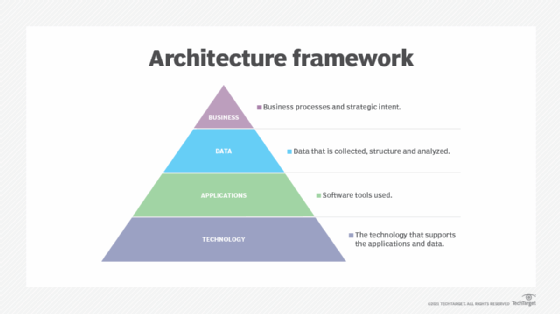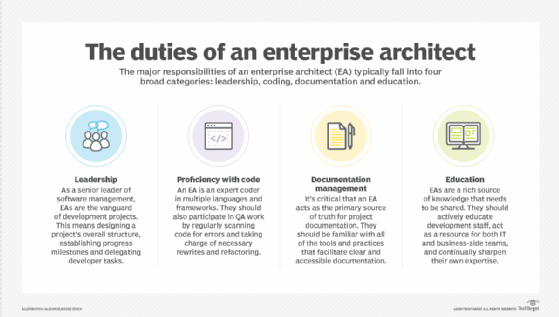What is enterprise architecture (EA)?
An enterprise architecture (EA) is a conceptual blueprint that defines an organization's structure and operation. Its intent is to determine how an organization can effectively achieve its current and future objectives.
Enterprise architecture involves analyzing, planning, designing and eventually implementing the analysis in an enterprise. Its use helps businesses going through digital transformation, since EA focuses on bringing legacy applications and processes together to form a seamless environment.
EA frameworks emerged in response to the increased use of business technologies during the 1980s. They were a way to respond to rapid technology growth. EA later expanded to encompass the entirety of a business, not just IT. This way, the rest of the company would be aligned with digital transformation.
Enterprise architecture concepts vary; they won't look the same for different organizations. Parts of an organization might also view EA differently. For example, programmers and other technical IT professionals regard enterprise architecture strategies in terms of the infrastructure, applications and management components they control. Enterprise architects, on the other hand, take a broader view, seeing EA as part of their business structure analysis.
The purpose of enterprise architecture
EA helps various departments in a business understand the broader business model and articulate challenges and business risks. It is vital in unifying and coordinating departmental processes across an organization. Accessing and understanding business capability should also help individuals identify gaps in their business and make more informed decisions based on this gap analysis.
One main goal of EA is to create a map or blueprint of an organization's structure and operations. This blueprint should include information, such as a map of IT assets and business processes.
Other common goals include promoting team alignment and standardization. This can be done, in part, by unifying environments across teams and organizations. Guidance is usually based on an organization's business requirements.
The enterprise architecture process
Microsoft's Michael Platt, a director in the strategic projects group, describes EA as having four points of view:
- The business perspective. This defines the processes and standards by which the business operates daily.
- The application perspective. This defines the interactions among the processes and standards the organization uses.
- The information perspective. This defines and classifies the raw data -- such as document files, databases, images, presentations and spreadsheets -- that the organization requires to operate efficiently.
- The technology perspective. This defines the hardware, operating systems, programming and networking tools the organization uses.
The term enterprise architecture has various meanings for different professionals, depending on where they work. For example, programmers and other technical IT professionals regard enterprise architecture strategies in terms of the infrastructure, application and management components they control.
High-level programmers use enterprise architecture to refer to the hardware and software components in a design. For a website, that might comprise a web server, database, the NoSQL database cache, the application programming interface endpoints and the content delivery network. Technical enterprise architects look at EA in the context of software architecture, systems architecture deployment types and other steps like testing.
Other IT professionals view enterprise architecture based on quality attributes. These attributes must exist for software to work and are unlikely to fit in a specification document. Examples include reliability, capacity, scalability and security. Quality elements aren't functional requirements but are ways to determine acceptable operating conditions and necessary tradeoffs to get there.
In a business context, enterprise architecture differs from the technical architecture required to build and run applications. Working from within an enterprise architecture framework helps define this.

EA models and methodologies
Enterprise architectures are typically implemented as frameworks. There are many different frameworks; some are a better fit than others for a specific organization.
For example, a large organization with many moving parts might find a framework focused on consistency and relationships between various parts of an overarching enterprise more useful.
Some examples of EA frameworks include the following:
- Zachman Framework for Enterprise Architecture. This covers six architectural points and six primary stakeholders who define and standardize IT architecture components.
- Unified Architecture Framework. This complex but flexible enterprise architecture framework is suitable for military and government software development. It's also used in commercial businesses and implemented as a Unified Modeling Language profile.
- Agile enterprise architecture. This focuses an organization around a flexible, extended collection of structures and processes that can grow. It can become an important part of Agile software delivery.
- Federal Enterprise Architecture Framework. This reference model was introduced in 1996 to improve IT effectiveness. It was designed for the U.S. government but is also used by private companies.
Other frameworks include The Open Group Architectural Framework, the European Space Agency Architectural Framework, the SAP Enterprise Architecture Framework and the Ministry of Defence Architecture Framework.
Benefits of enterprise architecture
Some advantages of having an enterprise architecture are the following:
- Improving decision-making.
- Enhancing adaptability to changing demands or market conditions.
- Eliminating inefficient and redundant processes.
- Optimizing the use of organizational assets.
- Minimizing employee turnover.
- Supporting organization redesigns and reorganizations.
- Facilitating the evaluation of architecture against long-term goals.
- Explaining IT architectures to those outside IT.
- Helping unify IT processes.
- Simplifying finance teams' work.
- Facilitating project management collaboration.
The role of enterprise architects
The enterprise architect is responsible for aligning an organization's IT strategy with its business objectives. They are charged with developing and maintaining an enterprise architecture management approach or framework that guides an organization on the technology needed to support its goals.
This guidance can include best practices that ensure IT investments in enterprise architecture contribute to efficiency and scalability, using continuously innovating technologies. Gartner considers this one of the most important roles of the enterprise architect. A successful enterprise architect can help organizations optimize resources and improve decision-making.
To create a cohesive architecture strategy, enterprise architects must collaborate with stakeholders such as business leaders and IT teams. This collaboration should involve assessing current systems, identifying gaps and recommending improvements.

Enterprise architecture stakeholders
Several important enterprise architecture stakeholders are involved in acquiring and maintaining an enterprise architecture. The most important are the following:
- Executives and business leaders.
- IT teams and developers.
- Project managers.
- Security and compliance teams.
- Operations and infrastructure teams.
EA vendors, tools and certifications
Several vendors sell enterprise architecture products and certifications focused on related skills. According to Gartner, examples of leading EA vendors include Ardoq, Bizdesign's Mega, Orbus Software and SAP.
Some EA tools provide visibility, keeping everyone from different departments on the same page. They can be easy to configure and let users pick the management type -- such as agile -- for each project.
Other EA software helps users develop strategic roadmaps and architectures that enable business and IT alignment. These tools enable business strategies and simplify technical architectures.
Some example certifications include the following:
- Amazon Web Services Certified Solutions Architect
- Cloud Credential Council's Professional Cloud Solutions Architect Certification
- ISC2's Information Systems Security Architecture Professional
- Open Group Certified Architect
- Salesforce Certified Technical Architect
Enterprise architecture is critical to success in the modern enterprise. Learn the four skills you shouldn't overlook as an enterprise architect.







